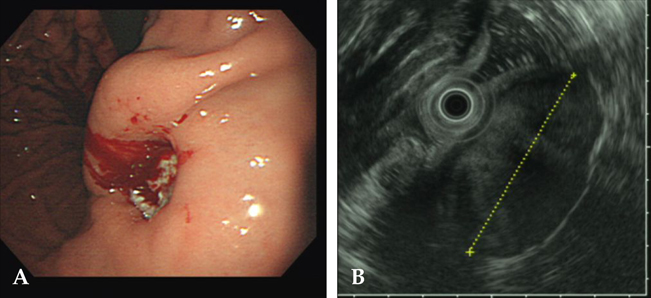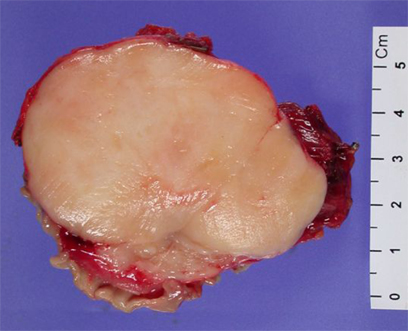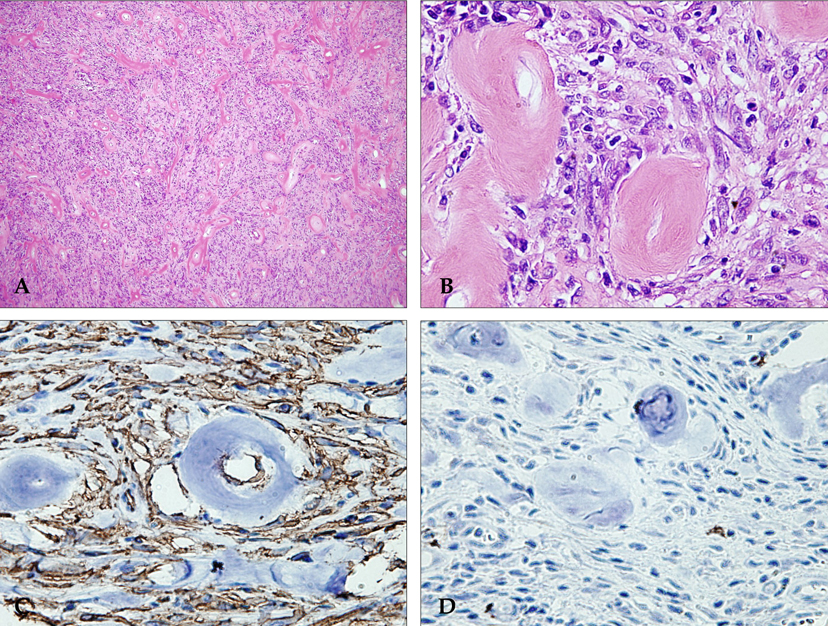Yonsei Med J.
2007 Dec;48(6):1056-1060. 10.3349/ymj.2007.48.6.1056.
Solitary Fibrous Tumor Arising from Stomach: CT Findings
- Affiliations
-
- 1Department of Diagnostic Radiology, Severance Hospital and Research Institute of Radiological Science, Yonsei University College of Medicine, Seoul, Korea. kimnex@yuhs.ac
- 2Institute of Gastroenterology and Brain Korea 21 Project for Medical Science, Yonsei University College of Medicine, Seoul, Korea.
- 3Department of Pathology, Severance Hospital and Research Institute of Pathological Science, Yonsei University College of Medicine, Seoul, Korea.
- KMID: 1786226
- DOI: http://doi.org/10.3349/ymj.2007.48.6.1056
Abstract
- Solitary fibrous tumors are spindle-cell neoplasms that usually develop in the pleura and peritoneum, and rarely arise in the stomach. To our knowledge, there is only one case reporting a solitary fibrous tumor arising from stomach in the English literature. Here we report the case of a 26-year-old man with a large solitary fibrous tumor arising from the stomach which involved the submucosa and muscular layer and resembled a gastrointestinal stromal tumor in the stomach, based on what was seen during abdominal computed tomography. A solitary fibrous tumor arising from the stomach, although rare, could be considered as a diagnostic possibility for gastric submucosal tumors.
Keyword
MeSH Terms
Figure
Reference
-
1. Gold JS, Antonescu CR, Hajdu C, Ferrone CR, Hussain M, Lewis JJ, et al. Clinicopathologic correlates of solitary fibrous tumors. Cancer. 2002. 94:1057–1068.2. Vossough A, Torigian DA, Zhang PJ, Siegelman ES, Banner MP. Extrathoracic solitary fibrous tumor of the pelvic peritoneum with central malignant degeneration on CT and MRI. J Magn Reson Imaging. 2005. 22:684–686.3. Shidham VB, Weiss JP, Quinn TJ, Grotkowski CE. Fine needle aspiration cytology of gastric solitary fibrous tumor: a case report. Acta Cytol. 1998. 42:1159–1166.4. Kindblom LG, Remotti HE, Aldenborg F, Meis-Kindblom JM. Gastrointestinal pacemaker cell tumor (GIPACT): gastrointestinal stromal tumors show phenotypic characteristics of the interstitial cells of Cajal. Am J Pathol. 1998. 152:1259–1269.5. Lee WA, Lee MK, Jeen YM, Kie JH, Chung JJ, Yun SH. Solitary fibrous tumor arising in gastric serosa. Pathol Int. 2004. 54:436–439.6. Rosado-de-Christenson ML, Abbott GF, McAdams HP, Franks TJ, Galvin JR. From the archives of the AFIP: Localized fibrous tumor of the pleura. Radiographics. 2003. 23:759–783.7. Goodlad JR, Fletcher CD. Solitary fibrous tumour arising at unusual sites: analysis of a series. Histopathology. 1991. 19:515–522.8. Fukunaga M, Naganuma H, Ushigome S, Endo Y, Ishikawa E. Malignant solitary fibrous tumour of the peritoneum. Histopathology. 1996. 28:463–466.9. Hasegawa T, Matsuno Y, Shimoda T, Hasegawa F, Sano T, Hirohashi S. Extrathoracic solitary fibrous tumors: their histological variability and potentially aggressive behavior. Hum Pathol. 1999. 30:1464–1473.10. Levy AD, Remotti HE, Thompson WM, Sobin LH, Miettinen M. Gastrointestinal stromal tumors: radiologic features with pathologic correlation. Radiographics. 2003. 23:283–304. 456; quiz 532.11. Horton KM, Juluru K, Montogomery E, Fishman EK. Computed tomography imaging of gastrointestinal stromal tumors with pathology correlation. J Comput Assist Tomogr. 2004. 28:811–817.12. McLeod AJ, Zornoza J, Shirkhoda A. Leiomyosarcoma: computed tomographic findings. Radiology. 1984. 152:133–136.13. Pannu HK, Hruban RH, Fishman EK. CT of gastric leiomyosarcoma: patterns of involvement. AJR Am J Roentgenol. 1999. 173:369–373.14. Horton KM, Fishman EK. Current role of CT in imaging of the stomach. Radiographics. 2003. 23:75–87.15. Dunfee BL, Sakai O, Spiegel JH, Pistey R. Solitary fibrous tumor of the buccal space. AJNR Am J Neuroradiol. 2005. 26:2114–2116.16. Miettinen M, Virolainen M, Maarit-Sarlomo-Rikala . Gastrointestinal stromal tumors--value of CD34 antigen in their identification and separation from true leiomyomas and schwannomas. Am J Surg Pathol. 1995. 19:207–216.17. Sarlomo-Rikala M, Kovatich AJ, Barusevicius A, Miettinen M. CD117: a sensitive marker for gastrointestinal stromal tumors that is more specific than CD34. Mod Pathol. 1998. 11:728–734.18. Fukunaga M, Naganuma H, Nikaido T, Harada T, Ushigome S. Extrapleural solitary fibrous tumor: a report of seven cases. Mod Pathol. 1997. 10:443–450.19. Vallat-Decouvelaere AV, Dry SM, Fletcher CD. Atypical and malignant solitary fibrous tumors in extrathoracic locations: evidence of their comparability to intra-thoracic tumors. Am J Surg Pathol. 1998. 22:1501–1511.20. Lowbeer L. Hypoglycemia-producing extrapancreatic neoplasms. A review. Am J Clin Pathol. 1961. 35:233–243.
- Full Text Links
- Actions
-
Cited
- CITED
-
- Close
- Share
- Similar articles
-
- Imaging Findings of a Solitary Fibrous Tumor in Pancreas: A Case Report
- Solitary Fibrous Tumor of the Adrenal Gland: A Case Report
- An Ancillary CT Finding of Intrapulmonary Solitary Fibrous Tumor: A Case Report
- A case of solitary fibrous tumor arising from the vagina
- Solitary Fibrous Tumor of the Trachea: CT Findings with a Pathological Correlation





